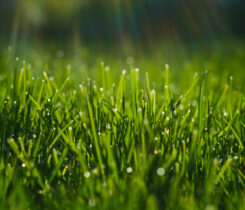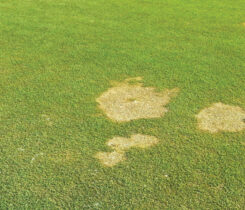Accessory war: debating the pros and cons of golf course accessories
The USGA in April last year released a report titled, “Eliminating Golf Course Accessories Saves Time and Money.” But that report’s release wasn’t the first time Matt Pauli, director of marketing for Standard Golf, took note of this idea.
The first time was a year earlier, when he couldn’t find a place to throw away his trash at his dad’s country club in Michigan.
“I talked to some people in the clubhouse and I asked, ‘Where are all the trash receptacles?’ and they told me they were going for a cleaner, crisper look,” Pauli recalls. “They told me to keep the trash in my cart. I said, ‘But what if I’m walking?’”
It’s no surprise an employee of Standard Golf would take umbrage at the idea of getting rid of trash bins on a golf course — Pauli has skin in the game. But according to Pauli, the members at the course also revolted.
“Members started piling trash on the tee boxes as a passive-aggressive protest,” Pauli laughs. “Accessories are our bread and butter, so I was happy to see it.”
Tee dance
The USGA report (available here) noted that accessories were removed from the West Course at Westchester CC in Rye, N.Y. Ball washers, benches, trash bins, divot mix containers and tee caddies were removed during a tee renovation project. Tee markers were reduced from five sets to three.

The usga says Golfers have come to expect course accessories without realizing how expensive and unnecessary they are. (Photo: Par Aide)
By removing the ball washers, officials estimated the course saved 380 labor hours and $3,000 in replacement parts and supplies for the year. Add in the removal of flowerbeds and the need for ropes, stakes, etc., Westchester CC estimates it will save 1,918 hours in labor and $10,500 in supplies.
The USGA further supported the report with a video entitled, “Fore the Golfer: Are Golf Course Accessories Worth the Hidden Costs?” Paul Jacobs, USGA Green Section Agronomist for the Northeast Region, narrates the video. “Golfers have come to expect course accessories without realizing how expensive and unnecessary they really are,” he says in the video.
Jacobs tells Golfdom that reaction to the report and video has been positive. He does not think reducing accessories will work for every course, but taking a critical look at how accessories fit into the overall plan is important, he says.
“The USGA is all about conserving resources and being as efficient as possible,” Jacobs says. “We asked ourselves,‘Are these dollars being spent on accessories because courses need to, or is it a case of historically, they’ve just always done it that way?’”
Jacobs says he thinks just about every golf course has reduced the number of accessories on the course in some way. And it’s not just about cost savings.
“When you remove these items from the golf course, people say the golf course feels grander, more open,” Jacobs says. “As a golfer, I agree.”

Brown suggests that simply adding one extra bunker rake in larger bunkers can speed up pace of play. (Photo: Par Aide)
The ‘clean’ look
Sean Reehoorn, superintendent at Aldarra Golf Club in Sammamish, Wash., is in the process of removing accessories at his course. He says he enjoys a “clean” look on every course he plays. One thing that drives him crazy, he says, is when there is a bench on a tee in front of him, disrupting his view.
There were no tee markers at Aldarra originally. Members would just tee it up from the same general area, playing a gentlemen’s game. Course managers then decided to get one set of tee markers for each tee. Now, to his chagrin, they have multiplied like gremlins — Aldarra has four sets of tee markers on each hole.
It was the same story with ball washers. The course had a few at first, then one on every hole. But the battle of ball washers is one Reehoorn is winning. All it’s taken is a little persuasion.
“We’ve been working on it over the last three, four years,” Reehoorn says. “I drop hint bombs to the members: ‘Hey, what if we (removed ball washers)?’ You have to get their support and explain what you’re trying to accomplish. You’ll always have some pushback. I joked to one guy, I’m going to give him one of the ball washers so he can put it in his locker.”
Aldarra is now down to one ball washer, and if it looks nervous, it should be — the last one is in Reehoorn’s sights.
“Not every hole needs a ball washer… and why are they on tees? If they should be anywhere it would be near a green,” he says. “Removing them saves labor, and that’s a factor for us. It’s hard to say I’m saving money but I am saving labor in the time it took to edge around them, paint them and make them look good.”

Ken Newcomb, former superintendent, now vice president of Par West Turf Services, says golf courses can have their accessories and labor savings, too. (Photo: Par Aide)
In defense of an icon
Dan Brown, sales and marketing manager for Par Aide Products Co., says it wasn’t the USGA’s report that first put accessories in the crosshairs. It was the Great Recession.
“Everyone was looking at their budgets and where they could possibly make cuts,” he says. “Labor, chemicals, overseeding, accessories… everything was on the list.”
Par Aide was prepared and had historical data to show golf course managers that it wasn’t accessories that were putting courses behind the 8-ball.
“For literally decades we have been tracking the amount an average course spends annually on accessories. It comes out to be 1 percent of their total maintenance budget, when you exclude labor and water,” Brown says. “This is an incredibly small dollar amount that is being spent on products that have a direct impact on a course’s image, pace of play, etc.”
Brown says Par Aide is always looking for new innovations, even for a product like their ball washer, which he calls “iconic.” But he doesn’t see the ball washer or any of their products as the bad guys on a golf course; they’re the good guys.
“Pace of play is a huge issue in golf right now, and accessories can play a critical role in speeding up rounds. For example, having the right number of bunker rakes in a bunker means a golfer won’t have to walk around a bunker, find a rake and then walk back to rake it, or worse, do it with their feet,” Brown says. “Private courses might be different, but at public courses, if there is the proper signage to make sure golfers know where they’re going, it will help cut down on unnecessary back-ups.”
Removing ball washers, Brown says, may cater to core golfers, but not to the average golfer.
“The average golfer doesn’t carry a towel to the green, they’re simply cleaning golf balls with their hands or not doing anything at all,” Brown says. “The tee is the only place on a hole, other than the cup, where all the golfers assemble at the same time, so it’s natural that it’s placed on the tee. The accessories also act as a waypoint for the tee, letting golfers who may not be familiar with the course know where the next tee is located.”
Brown says Par Aide respects the idea of keeping the golf course looking clean, but he’s not buying the idea that accessories are high maintenance.
“We’ve done the survey work, we asked superintendents how much time the crew spends wiping down ball washers, refilling them, emptying the trash and general attending of ‘tee accessories,’” Brown says. “It averaged out to 91 minutes a month. People aren’t taking them off the course because they require a crazy amount of maintenance. If they are, it’s generally more for aesthetic reasons.”
Both sides now
The best perspective on the accessory debate might come from someone who has worked on both sides of the tee markers — as a superintendent buying and maintaining accessories and as a businessperson selling them.
Say hello to Ken Newcomb, who spent 15 years as a superintendent and who three years ago became the vice president of Par West Turf Services.
Par West Turf Services, based in Huntington Beach, Calif., is one of the largest distributors of golf course and landscape products in the country, selling both Par Aide and Standard Golf products.
“(Removing accessories) has been on my radar since I started as a superintendent,” Newcomb says. “When you worked at a private club, the idea was not to put much out because it’s the members’ club and they knew where everything was. When we first started putting accessories out, there was a backlash that we were making the course look ‘public.’ Then the members started liking the accessories and it went from one extreme to the other.”
Newcomb believes courses are finding the proper balance when it comes to accessories. Putting a lot of accessories on a course can take away from the course’s natural beauty, he says. But he also believes that a nice tee set up with a ball washer, a sign and a flower bed can be a great complement at many courses.
As for the potential cost savings?
“The accessory budget is such an insignificant line item in the overall budget,” he says. “The cost savings is in the labor savings.”
Speaking like a superintendent, he advises courses to work smarter, not harder. Courses can have accessories and labor savings, he says.
“Five sets of tees, a ball washer, a tee caddie — that all has to be moved and put back,” he says. “When I worked for ClubCorp, they advised us to move all that off the grass and keep it in concrete so it doesn’t slow the crew down. Because once the crew gets caught by play they move at a snail’s pace.”
Happily for Newcomb, he has not seen a downward trend in accessories sales. He also saw something during a recent round in Orange County, Calif., that makes him think courses might be finding new ways to accessorize.
“I played a course with $200 greens fees, and they had cornhole boards behind the first tee,” Newcomb says. “They had music playing over the speakers by the snack bar. We grabbed a drink and played cornhole while we waited to tee off. It was a cool use of amenities to make the day more fun.”













Amazing blog! I’ve started golfing a few days ago. These pieces of information were very much needed for me. Thank you for writing an informative article. Thanks once again.